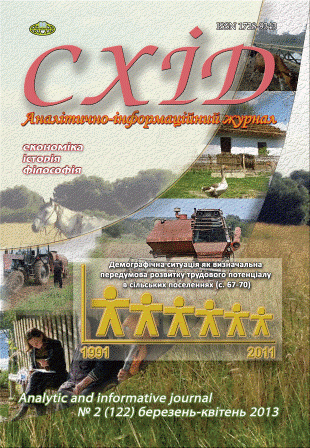Decent work on industrial enterprise based the approach competentive
DOI:
https://doi.org/10.21847/1728-9343.2013.2(122).13452Keywords:
competencies, model, personnel, management, decent workAbstract
The article proves that achieving decent work possible under the coordination purposes of the enterprise with the goals of employees on the basis of explicit requirements as to such employees to the production process. In connection with the proposed use of the competency approach to create such a system of priorities, and the control scheme of responsibility includes managing staff, working conditions and social processes. Based on the generalization of human resource management processes proposed scheme using competency models to achieve decent work, which must conform to the principles of consistency, respect and human dignity, team unity, horizontal cooperation, legal and social protection. Also in the formation of decent work in the enterpriseincreases the role additional principles: long-term records of the organization, integration and team cohesion, participation of employees in decision making, reliance on professional core human resources, balancing the interests of managers and subordinate employees, cooperation with trade unions and public. These principles must be formed and regulated competency models at appropriate stages of HR ranging from selection procedures for the vacant position and ending with the adoption of a decision to move up the career ladder or dismissal from office. Implementation of competency models in the form of clearly defined rights, responsibilities and recommendations to the parties to labor relations will settle conflicts in social and labor issues, reduce the number of acts of protest and dissatisfaction, increase the responsibility for the results of work.
Downloads
References
Верба В. А. Управлінське консультування: концепція, організація, розвиток : [монографія] / В. А. Верба. - К. : КНЕУ, 2011. - 327 с.
Гага В. А. Современная парадигма труда / В. А. Гага, Е. В. Нехода. - Томск : Интернет-издательство ВШБ ТГУ, 2008. - 80 с.
Спенсер Л. М. Компетенции в работе / Л. М. Спенсер ; [пер с англ.]. - М. : HIPPO, 2005. - 384 с.
Скляр Є. П. Сутність та складові компетенції персоналу / Є. П. Скляр // Економіка, менеджмент, підприємництво : зб. наук. праць Східноукраїнського національного університету імені В. Даля. - 2011. - № 23(І). - Ч. 1. - С. 174-179.
Prahalad C. K. The core competence of the corporation / C. K. Prahalad, G. Hamel // Harvard Business Review. - 1990. - May-June. - Рр. 79-93.
Guerrieri P. National Competitive Advantages and
Microeconomics Behaviour / P. Guerrieri, A. Tylecote // Economics of Innovation and New Technology. - 1994. - № 3. - Рp.49-76.
Hitt M. A. Strategic management: competitiveness and globalization / M. A. Hitt. - West Publishing Company, 1995. - 1085 p.
Verba V. A. (2011), Management consulting: conception, organization development, Kyiv National Economic University, Kyiv, 327 р.
Haha V. A., Nekhoda E. V. (2008), Modern Paradigm labor, Tomsk, 80 р.
Spenser L. M. (2005), Competence in the work, Moscow, 384 р.
Skliar Ye. P. (2011), Essence and elements of competence of personnel, Ekonomika, menedzhment, pidpryiemnytstvo, zbirnyk naukovykh prats Skhidnoukrainskoho natsionalnoho universytetu imeni V.Dalia, No. 23(I), рart 1, рр. 174-179.
Prahalad C. K., Hamel G. (1990),The core competence of the corporation, Harvard Business Review, May-June, pр. 79-93.
Guerrieri P., Tylecote A. (1994), National Competitive Advantages and Microeconomics Behaviour, Economics of Innovation and New Technology, No. 3, pp. 49-76.
Hitt M. A. (1995), Strategic management: competitiveness and globalization, West Publishing Company, 1085 p.
Downloads
Published
How to Cite
Issue
Section
License
Copyright (c) 2013 Nataliia Humeniuk

This work is licensed under a Creative Commons Attribution-NonCommercial-NoDerivatives 4.0 International License.
1. Authors bear responsibility for the accuracy of facts, quotations, numbers and names used.
2. Manuscripts are not sent back.
3. The publisher does not always agree with the authors' opinion.
4. The authors reserve the right to authorship of the work and pass the first publication right of this work to the journal under the terms of a Creative Commons Attribution-NonCommercial-NoDerivatives 4.0 International License. This license allows others to distribute (copy) the published work for non-commercial purposes, provided there is mandatory attribution to its authors and a link to the first publication in our journal.
5. The authors have the right to conclude separate supplement agreements that relate to non-exclusive work distribution in the form in which it has been published by the journal (for example, to upload the work to the online storage of the journal or publish it as part of a monograph), provided that the reference to the first publication of the work in this journal is included.

